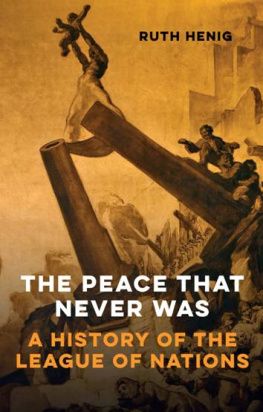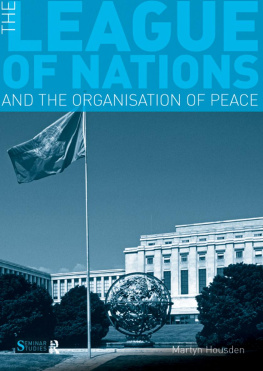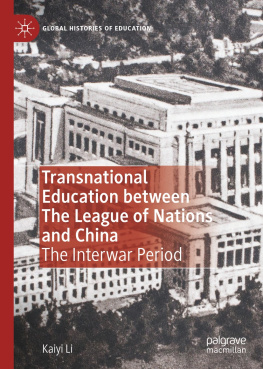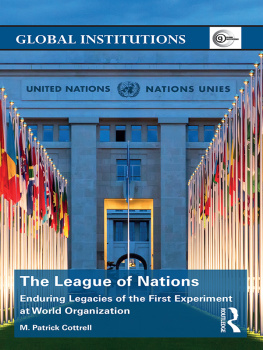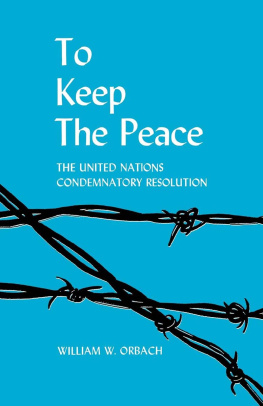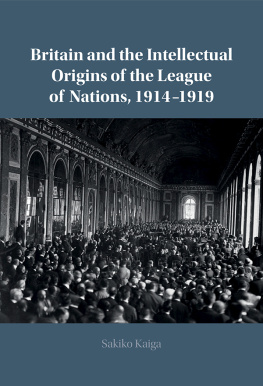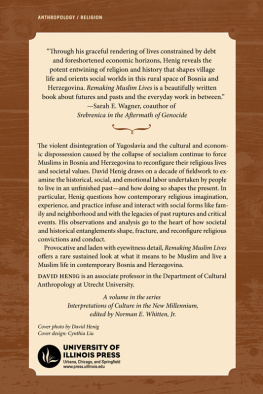Ruth Henig - The Peace That Never Was: A History of the League of Nations
Here you can read online Ruth Henig - The Peace That Never Was: A History of the League of Nations full text of the book (entire story) in english for free. Download pdf and epub, get meaning, cover and reviews about this ebook. year: 2019, publisher: Haus Publishing, genre: Politics. Description of the work, (preface) as well as reviews are available. Best literature library LitArk.com created for fans of good reading and offers a wide selection of genres:
Romance novel
Science fiction
Adventure
Detective
Science
History
Home and family
Prose
Art
Politics
Computer
Non-fiction
Religion
Business
Children
Humor
Choose a favorite category and find really read worthwhile books. Enjoy immersion in the world of imagination, feel the emotions of the characters or learn something new for yourself, make an fascinating discovery.
- Book:The Peace That Never Was: A History of the League of Nations
- Author:
- Publisher:Haus Publishing
- Genre:
- Year:2019
- Rating:3 / 5
- Favourites:Add to favourites
- Your mark:
- 60
- 1
- 2
- 3
- 4
- 5
The Peace That Never Was: A History of the League of Nations: summary, description and annotation
We offer to read an annotation, description, summary or preface (depends on what the author of the book "The Peace That Never Was: A History of the League of Nations" wrote himself). If you haven't found the necessary information about the book — write in the comments, we will try to find it.
Ruth Henig: author's other books
Who wrote The Peace That Never Was: A History of the League of Nations? Find out the surname, the name of the author of the book and a list of all author's works by series.
The Peace That Never Was: A History of the League of Nations — read online for free the complete book (whole text) full work
Below is the text of the book, divided by pages. System saving the place of the last page read, allows you to conveniently read the book "The Peace That Never Was: A History of the League of Nations" online for free, without having to search again every time where you left off. Put a bookmark, and you can go to the page where you finished reading at any time.
Font size:
Interval:
Bookmark:



Published in 2019 by
Haus Publishing Ltd
4 Cinnamon Row
London sw11 3tw
www.hauspublishing.com
A previous edition was published in 2010
Copyright Ruth Henig, 2019
The moral right of the author has been asserted
A CIP catalogue record for this book
is available from the British Library
ISBN 978-1-910376-78-2
eISBN 978-1-912208-56-2
Typeset in Sabon by MacGuru Ltd
Printed in Spain by Liberdplex
Maps by Martin Lubikowski, ML Design, London
All rights reserved.
For Samuel, Lucy, Bobby and Eric
My greatest debt is to Professor Alan Sharp, who has suggested for many years that I should write a history of the League of Nations, and who finally found a way of bringing it about. I would like to thank him and Jen for their friendship, hospitality and intellectual stimulation over more years than I care to remember. I would also like to thank Mark Rowe for sending me books and articles relating to the League and for his interest in the progress of the manuscript. Barbara Schwepcke of Haus Publishing has been consistently helpful and supportive, and I would also like to thank Jaque-line Mitchell for dealing so calmly with my rather erratic early drafts and for all her help with the pictures and the text. Finally, this book would not have been completed without the unfailing support and encouragement of my husband, Jack, who was always ready to cheer me up or to carry me off to a nearby hostelry when I needed a break from writing. Needless to say, neither he nor the alcohol are to blame for any remaining errors of fact or of punctuation in the final text.
When I started writing about the League of Nations 50 years ago, there was general agreement amongst diplomatic historians that the League was a total failure. Its central task had been to prevent the outbreak of another major war, and it had comprehensively failed. A J P Taylor, a historian of very decided views, declared that in the study of the inter-war period, the League was a complete irrelevance. More recently, in her major book Peacemakers, published in 2001, Canadian historian Margaret MacMillan commented with-eringly that only a handful of eccentric historians still bother to study the League of Nations.
The focus of enquiry in the 1960s and 1970s was therefore on the causes of League failure. Broadly speaking, two main lines of analysis were pursued. On the one hand, it was argued that states had failed to live up to the commitments they had agreed to in the League Covenant they paid lip service to them, but in practice were driven by national ambition, greed and self-interest. Many who took this view were European left-wing idealists, or American admirers of Woodrow Wilson who believed that the American Presidents attempts to construct a better world after 1919 were sabotaged by European leaders. A second group argued that, on the contrary, the aims of the League were far too ambitious and idealistic, and were inevitably undermined by considerations of realpolitik. Viewed from this perspective, Wilson was not the hero but the villain, and his scheme of guaranteeing League members territorial integrity and political independence, plus the pursuit of unrealistic schemes of armament limitation, were seen as unachievable in a world of competing great powers. Some argued that a more limited scheme of international co-operation might have worked, but basically, as Wittgenstein commented, to assess why the League failed, historians first needed to find out why wolves eat lambs. So the best that could be said of the League in the decades immediately after the Second World War was that it had at least laid the foundations for the United Nations and its range of ancillary bodies, and that the United Nations would hopefully succeed where the League had failed in bringing lasting peace and prosperity to an exhausted world.
Fast-forward 50 years, and the League is being viewed by a range of younger historians in a very different and more positive light. In the first instance, the United Nations has faced similar problems to the League in relation to conflict resolution and arms limitation. Its peacekeeping record makes the Leagues settlement of a range of territorial disputes in the 1920s appear very respectable. Secondly, we can now see much more clearly than was possible in the 1950s and 60s that the Great War of 191418 unleashed such powerful tremors across the globe, a veritable tsunami, that many historians now claim that it was not until the early 1990s that the full effects of the conflict finally subsided. Thus the impact of the Great War did not just destabilise the inter-war period, but caused serious international instability for at least 30 years thereafter. How could the League possibly operate effectively in such a volatile and hostile environment? But just because it had inevitably failed to prevent renewed conflict after 1919 was not a reason for ignoring its successes in other aspects of its work. Rather than judging the League on one area of its activities, however important, historians now argue that a wider view should be taken of the Leagues activities, acknowledging that in many diverse fields it was extremely successful. Thus, in the past two decades, the League has been portrayed in an increasingly positive light. Given the circumstances of its birth, given that it was a very complex organisation offering not just a variety of routes of escape from war but an unprecedented level of inter-state co-operation across a wide variety of fields, and given its early abandonment by the United States, much of its work is now seen as pioneering and as of considerable importance. Crucially, it helped to establish internationally accepted norms of conduct between sovereign states in relation to minority rights, trusteeship principles and the establishment and safeguarding of human rights. The horrors of the Second World War only served to underline just how important it was for states to agree to uphold such norms both in their internal and external activities; thus the development of recent human rights legislation, concepts of minority rights and of orderly transition to state-hood can be traced back in origin to the work of the League.
Furthermore, the Leagues work in the fields of humanitarian relief, exchange of populations, international labour organisation, the establishment of an international court, financial and economic co-operation, the combatting of global health epidemics and the drugs trade and a whole host of other humanitarian activities were all truly ground-breaking, and continue to this day through United Nations agencies and other global bodies. Even more innovative was the establishment of the League Secretariat and the rise of the international civil servant and the NGO expert here, the League paved the way for our modern international landscape and for a range of international bodies and initiatives, including the European Union. As Lord Cecil pointed out at the Leagues last meeting in 1946, The work of the League is purely and unmistakeably printed on the social, economic and humanitarian life of the world. That is even more true today than it was in 1946. The League was indeed the worlds first major international global organisation.
Font size:
Interval:
Bookmark:
Similar books «The Peace That Never Was: A History of the League of Nations»
Look at similar books to The Peace That Never Was: A History of the League of Nations. We have selected literature similar in name and meaning in the hope of providing readers with more options to find new, interesting, not yet read works.
Discussion, reviews of the book The Peace That Never Was: A History of the League of Nations and just readers' own opinions. Leave your comments, write what you think about the work, its meaning or the main characters. Specify what exactly you liked and what you didn't like, and why you think so.

